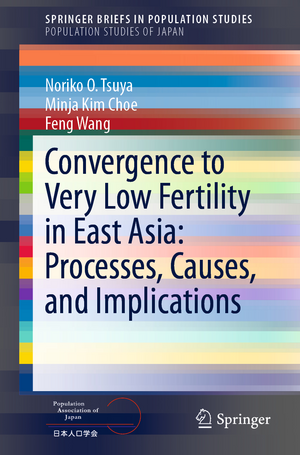Convergence to Very Low Fertility in East Asia: Processes, Causes, and Implications: SpringerBriefs in Population Studies
Autor Noriko O. Tsuya, Minja Kim Choe, Feng Wangen Limba Engleză Paperback – 4 apr 2019
Din seria SpringerBriefs in Population Studies
-
 Preț: 344.90 lei
Preț: 344.90 lei -
 Preț: 177.49 lei
Preț: 177.49 lei -
 Preț: 355.53 lei
Preț: 355.53 lei -
 Preț: 317.19 lei
Preț: 317.19 lei -
 Preț: 442.62 lei
Preț: 442.62 lei - 15%
 Preț: 463.03 lei
Preț: 463.03 lei - 15%
 Preț: 463.68 lei
Preț: 463.68 lei -
 Preț: 377.57 lei
Preț: 377.57 lei -
 Preț: 414.42 lei
Preț: 414.42 lei -
 Preț: 476.57 lei
Preț: 476.57 lei -
 Preț: 376.80 lei
Preț: 376.80 lei -
 Preț: 376.22 lei
Preț: 376.22 lei -
 Preț: 377.73 lei
Preț: 377.73 lei -
 Preț: 477.17 lei
Preț: 477.17 lei -
 Preț: 379.09 lei
Preț: 379.09 lei -
 Preț: 346.66 lei
Preț: 346.66 lei -
 Preț: 380.07 lei
Preț: 380.07 lei -
 Preț: 343.88 lei
Preț: 343.88 lei -
 Preț: 374.46 lei
Preț: 374.46 lei -
 Preț: 343.39 lei
Preț: 343.39 lei -
 Preț: 205.29 lei
Preț: 205.29 lei -
 Preț: 378.92 lei
Preț: 378.92 lei -
 Preț: 375.23 lei
Preț: 375.23 lei -
 Preț: 378.34 lei
Preț: 378.34 lei -
 Preț: 474.84 lei
Preț: 474.84 lei -
 Preț: 476.42 lei
Preț: 476.42 lei -
 Preț: 379.09 lei
Preț: 379.09 lei -
 Preț: 476.79 lei
Preț: 476.79 lei -
 Preț: 441.85 lei
Preț: 441.85 lei - 15%
 Preț: 461.73 lei
Preț: 461.73 lei -
 Preț: 375.23 lei
Preț: 375.23 lei -
 Preț: 259.96 lei
Preț: 259.96 lei -
 Preț: 343.88 lei
Preț: 343.88 lei -
 Preț: 442.62 lei
Preț: 442.62 lei -
 Preț: 474.67 lei
Preț: 474.67 lei -
 Preț: 443.75 lei
Preț: 443.75 lei -
 Preț: 443.00 lei
Preț: 443.00 lei -
 Preț: 262.09 lei
Preț: 262.09 lei -
 Preț: 376.80 lei
Preț: 376.80 lei -
 Preț: 377.18 lei
Preț: 377.18 lei -
 Preț: 311.91 lei
Preț: 311.91 lei -
 Preț: 376.59 lei
Preț: 376.59 lei -
 Preț: 174.62 lei
Preț: 174.62 lei -
 Preț: 379.09 lei
Preț: 379.09 lei -
 Preț: 477.72 lei
Preț: 477.72 lei -
 Preț: 340.45 lei
Preț: 340.45 lei -
 Preț: 374.85 lei
Preț: 374.85 lei
Preț: 475.22 lei
Nou
Puncte Express: 713
Preț estimativ în valută:
90.93€ • 95.20$ • 75.24£
90.93€ • 95.20$ • 75.24£
Carte tipărită la comandă
Livrare economică 05-19 aprilie
Preluare comenzi: 021 569.72.76
Specificații
ISBN-13: 9784431557807
ISBN-10: 4431557806
Pagini: 70
Ilustrații: XI, 66 p. 7 illus., 6 illus. in color.
Dimensiuni: 155 x 235 x 31 mm
Greutate: 0.12 kg
Ediția:1st ed. 2019
Editura: Springer
Colecția Springer
Seriile SpringerBriefs in Population Studies, Population Studies of Japan
Locul publicării:Tokyo, Japan
ISBN-10: 4431557806
Pagini: 70
Ilustrații: XI, 66 p. 7 illus., 6 illus. in color.
Dimensiuni: 155 x 235 x 31 mm
Greutate: 0.12 kg
Ediția:1st ed. 2019
Editura: Springer
Colecția Springer
Seriile SpringerBriefs in Population Studies, Population Studies of Japan
Locul publicării:Tokyo, Japan
Public țintă
ResearchCuprins
Introduction.- 1. Cultural Backgrounds, Economic Transformations, and Institutional Contexts.- 2. Evolution of Population and Family Policies.- 3. Trends of Fertility Change.- 4. Changes in the Age Patterns of Fertility.- 5. Demographic Factors of Fertility Change.- 5.1 Age patterns of marriage.- 5.2 Childbearing within marriage.- 5.3 Patterns of family building .- 6. Socioeconomic Factors of Fertility Change.- 6.1 Education.- 6.2 Women’s employment.- 6.3 Gender relations at home.- 6.4 Attitudes toward marriage and family.- Conclusions and Policy Implications.
Caracteristici
Examines fertility declines in Japan, South Korea, and China, which are notable in their rapidity and magnitude Shows how rapid fertility declines in the three East Asian countries have resulted in extreme population aging and will result in rapid population shrinkage Explains how the economic impacts of population aging and decline are profound and global as these countries produced nearly one-quarter of the world GDP in 2013












